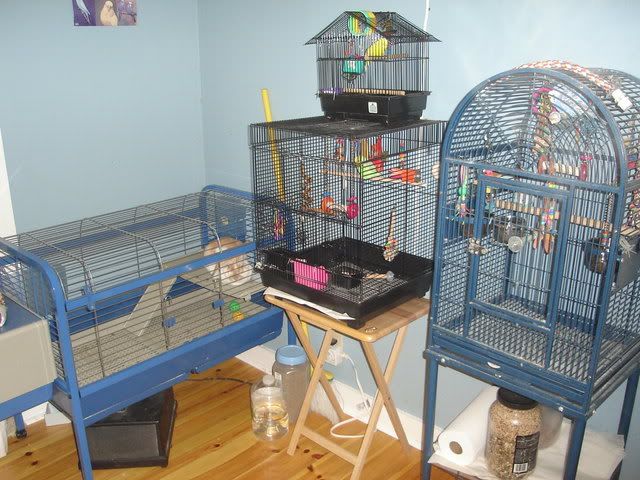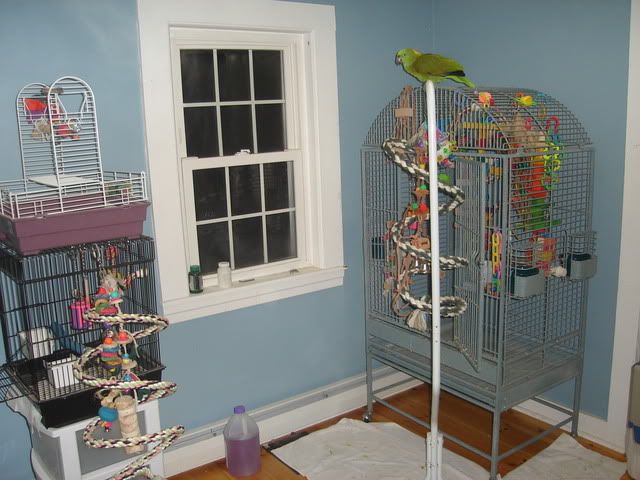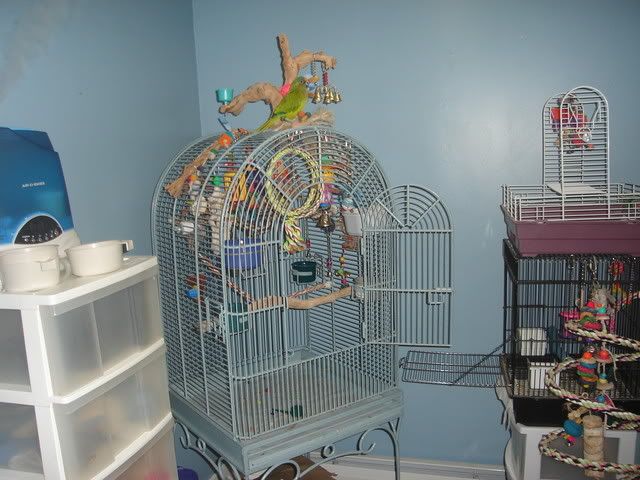The importance of sleep in captive birds
One of the
questions I ask first, when doing a bird behavior consult, is how many
hours of uninterrupted sleep does your parrot receive? Many people do
not know or understand how important sleep is to our captive birds.
If people are experiencing issues with their bird, in terms of screaming, biting, feather mutilation, it can be related to the hours of day and night the bird is experiencing. Birds should receive a minimum of 10 hours of sleep a night, and my usual recommendation is 12 hours.
Also, another important factor is that the sleep be uninterrupted. If you put your bird to bed at 8pm every night, but your bird's cage is in your living room, and you are up until 1am every night watching TV, your bird is not getting uninterrupted sleep from 8pm - 1am. Most birds are up at sunrise, unless they are covered or in a very dark part of the house in the morning. So think of it this way, at best your bird was asleep soundly at 1am after you went to bed, and then up around 8am when the sun came in the living room window's. That is only 7 hours of uninterrupted sleep!
There are many reasons why birds need so much sleep. One of major reasons is that most of our captive birds originate in countries much closer to the equator where day and night are each about 12 hours. Although this doesn't hold true to all species, and even near the equator there is some variation, I believe the closer our birds waking and sleeping hours match their wild habits, the better.
There are a number of ways to help make sure your bird gets 10-12 hours of sleep. If you have your bird in a room that is used by people until late at night, it may be a good idea to buy your bird a sleeping cage that you can put in a quieter part of the house. At 8pm, you can take your bird to this cage and put them to bed. The sleeping cage can be much smaller than your bird's normal daytime cage, since it is used only for sleeping, and also doesn't need many toys, maybe just one or two, and some dry food and water. When you get up in the morning, you return them to their larger daytime cage.
If your bird is in a reasonably quiet part of your house already, but you are not quite sure they are getting enough sleep, covering your birds with a dark sheet, may help your bird sleep more soundly through the night.
In my house, I have several of my own birds, in addition to frequent boarding birds, so I have a room set aside for the birds to spend most of the day in. In this situation, I have lights on timers that are set to stay on for exactly 12 hours. My birds lights come on around 8:30am and turn off around 8:30pm. They are probably awake before 8:30am because some light shines through the curtains on the window, but they are at a bare minimum sleeping 10 hours if not more. With a separate room, I don't need to cover my birds, and pay attention to what I am doing after they are in bed for the night.
There is also the option of waking your birds up later in the morning and staying up a little later with them at night. There is no reason why you can't train your bird to sleep from 10pm -10am or even later. Just make sure to keep the house dark with blackout curtains in the area where your bird sleeps.
If people are experiencing issues with their bird, in terms of screaming, biting, feather mutilation, it can be related to the hours of day and night the bird is experiencing. Birds should receive a minimum of 10 hours of sleep a night, and my usual recommendation is 12 hours.
Also, another important factor is that the sleep be uninterrupted. If you put your bird to bed at 8pm every night, but your bird's cage is in your living room, and you are up until 1am every night watching TV, your bird is not getting uninterrupted sleep from 8pm - 1am. Most birds are up at sunrise, unless they are covered or in a very dark part of the house in the morning. So think of it this way, at best your bird was asleep soundly at 1am after you went to bed, and then up around 8am when the sun came in the living room window's. That is only 7 hours of uninterrupted sleep!
There are many reasons why birds need so much sleep. One of major reasons is that most of our captive birds originate in countries much closer to the equator where day and night are each about 12 hours. Although this doesn't hold true to all species, and even near the equator there is some variation, I believe the closer our birds waking and sleeping hours match their wild habits, the better.
There are a number of ways to help make sure your bird gets 10-12 hours of sleep. If you have your bird in a room that is used by people until late at night, it may be a good idea to buy your bird a sleeping cage that you can put in a quieter part of the house. At 8pm, you can take your bird to this cage and put them to bed. The sleeping cage can be much smaller than your bird's normal daytime cage, since it is used only for sleeping, and also doesn't need many toys, maybe just one or two, and some dry food and water. When you get up in the morning, you return them to their larger daytime cage.
If your bird is in a reasonably quiet part of your house already, but you are not quite sure they are getting enough sleep, covering your birds with a dark sheet, may help your bird sleep more soundly through the night.
In my house, I have several of my own birds, in addition to frequent boarding birds, so I have a room set aside for the birds to spend most of the day in. In this situation, I have lights on timers that are set to stay on for exactly 12 hours. My birds lights come on around 8:30am and turn off around 8:30pm. They are probably awake before 8:30am because some light shines through the curtains on the window, but they are at a bare minimum sleeping 10 hours if not more. With a separate room, I don't need to cover my birds, and pay attention to what I am doing after they are in bed for the night.
There is also the option of waking your birds up later in the morning and staying up a little later with them at night. There is no reason why you can't train your bird to sleep from 10pm -10am or even later. Just make sure to keep the house dark with blackout curtains in the area where your bird sleeps.
.JPG)
.JPG)






